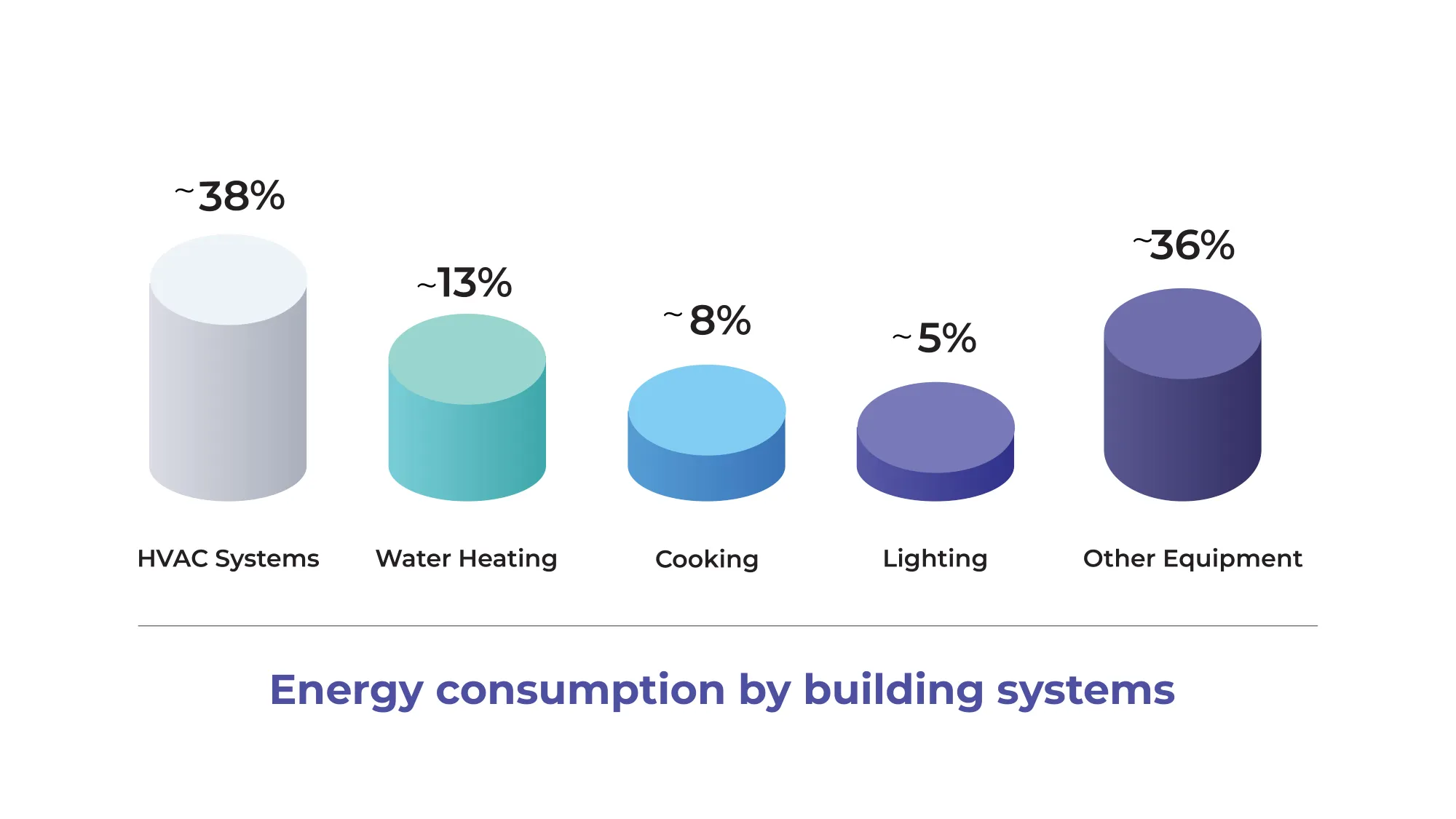What is Energy Use Intensity (EUI)?
At its core, EUI assesses a building’s energy efficiency by calculating the total energy consumed annually per square foot. A lower EUI – also known as a “good” EUI – means better efficiency, lower operational costs, and a smaller environmental footprint.
EUI = Total Annual Energy Consumed (kBtu) ÷ Total Gross Floor Area (sq. ft.)
EUI comes in two main types:
- Site EUI: Captures the direct energy consumption of a building, typically shown on energy bills.
Want more guidance on how to understand your energy costs? Read this. - Source EUI: Accounts for the total energy used, including energy consumed at power plants to operate the building.
While Site EUI focuses on direct consumption, Source EUI provides a broader view of a building’s total energy footprint. Understanding both allows for informed energy management decisions.
Why Measure EUI?
By tracking EUI, businesses can pinpoint high-consumption areas, set energy-saving goals, and make smarter, more sustainable decisions.
EUI serves as a powerful assessing tool for optimising building performance by:
- Establishing a baseline to compare energy use intensity across buildings and energy sources.
- Detecting high-consumption areas to reduce operational costs.
- Ensuring compliance with energy codes and sustainability programs (e.g., ENERGY STAR and the 2030 Challenge).
- Using data-driven insights to improve future building designs and retrofits.
For example, New York’s Empire State Building underwent a green retrofit with LED lighting upgrades, regenerative‑braking elevators, chiller plant modernization, and more, cutting the building’s energy usage by 40%, saving more than $4 million every year, showing how a data-driven, holistic retrofit can lower EUI in commercial spaces.
From Design to Operation: What Impacts EUI in Buildings?
EUI varies significantly based on a building’s type, location, and operational demands, with factors like building systems, usage patterns, and climate playing a significant role in determining EUI values. Here’s what you need to know to better understand consumption patterns and analyse the data at your fingertips:
- By building systems
Energy consumption in buildings is distributed across key systems such as HVAC, lighting, and water heating, each impacting the total energy footprint differently.

-
By building type
EUI varies by building type, depending on the need and usage of the space. Hospitals, labs, and data centers tend to have higher EUIs due to their intensive energy needs. In contrast, commercial buildings and schools typically have lower EUIs due to predictable schedules, limited hours, and seasonal breaks. - By climate patterns
Colder climates lead to higher EUI in winter. To assess performance fairly, EUI should be weather-normalized using Heating Degree Days (HDD) and Cooling Degree Days (CDD). - Renewable Energy Integration
Incorporating on-site renewable energy sources, such as solar panels or wind turbines, helps offset energy use and effectively reduces the building’s net EUI.
Strategies to improve EUI
Improving a building’s Energy Use Intensity (EUI) isn’t about one big change—it’s the result of smart, strategic steps. From equipment upgrades to data-driven decision-making, here are practical ways to lower your EUI and enhance overall efficiency:
- Optimize Energy Management through Smart Technologies
Centralize HVAC, lighting, and energy systems using IoT-enabled controls. Enable real-time monitoring and predictive maintenance to ensure optimal performance based on occupancy, weather, and equipment conditions. - Incorporate On-site Renewable Energy
Adopt solar, wind, or geothermal solutions to offset grid reliance. Add battery storage for better energy utilization and lower net EUI. - Leverage Data and AI Analytics
Platforms like EdificeDX turn system-wide data into actionable insights—enabling continuous optimization aligned with sustainability goals. - Promote Occupant Awareness
Display energy usage trends to encourage responsible behavior and support long-term energy-saving habits. - Upgrade Equipment and Operations
Use energy-efficient equipment (LEDs, high-efficiency HVACs, ENERGY STAR appliances). Monitor performance in real time to validate projected savings. - Conduct Regular Energy Audits
Identify inefficiencies, measure upgrade impact, and fine-tune strategies to sustain energy performance improvements.
How EdificeDX helps track EUI
EdificeDX seamlessly integrates with building automation systems to continuously collect and analyze energy data, helping identify high-consumption areas and implement targeted efficiency strategies. It offers visual dashboards to monitor energy trends across systems, floors, and buildings, along with weather-normalized insights for more accurate EUI evaluation. With vendor-agnostic integration, customizable alerts, fault detection, and the ability to set performance benchmarks, EdificeDX empowers smarter energy decisions, improved operational efficiency, and long-term sustainability.
With EdificeDX, you don’t just track energy—you transform it into a strategic advantage.
EUI is more than just a metric—it reflects how consciously and efficiently we use energy. And in an era where AI and data fuels smarter decisions, EUI is the key to unlocking hidden energy efficiencies. By making EUI a core part of your strategy, you’re not just cutting costs, you’re making every kilowatt count – to build a smarter, more sustainable future.